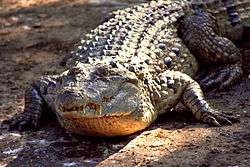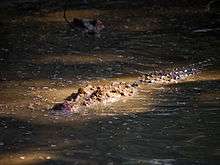Philippine crocodile
| Philippine Crocodile | |
|---|---|
 | |
| An adult Crocodylus mindorensis basking | |
| Scientific classification | |
| Kingdom: | Animalia |
| Phylum: | Chordata |
| Class: | Reptilia |
| Order: | Crocodilia |
| Family: | Crocodylidae |
| Genus: | Crocodylus |
| Species: | C. mindorensis |
| Binomial name | |
| Crocodylus mindorensis Schmidt, 1935 | |
| | |
| Range of the Philippine crocodile in blue | |
The Philippine crocodile (Crocodylus mindorensis), also known as the Mindoro crocodile, the Philippine freshwater crocodile or locally, bukarot,[1] is one of two species of crocodiles found in the Philippines; the other is the larger Indo-Pacific crocodile or saltwater crocodile (Crocodylus porosus).[2][3] The Philippine crocodile, the species endemic only to the country, became data deficient to critically endangered in 2008 from exploitation and unsustainable fishing methods,[4] such as dynamite fishing.[5] Conservation methods are being taken by the Dutch/Filipino Mabuwaya foundation,[6] the Crocodile Conservation Society and the Zoological Institute of HerpaWorld in Mindoro island. It is strictly prohibited to kill a crocodile in the country, and it is punishable by law.
Taxonomy and etymology
Until 1989, it was considered a subspecies of the New Guinea crocodile (Crocodylus novaeguineae).[7]
Characteristics
The Philippine crocodile is a crocodilian endemic to the Philippines. It is a relatively small, freshwater crocodile. It has a relatively broad snout and thick bony plates on its back (heavy dorsal armor). This is a fairly small species, reaching breeding maturity at 1.5 m (4.9 ft) and 15 kg (33 lb) in both sexes and a maximum size around 3.1 m (10 ft).[7] Females are slightly smaller than males. Philippine crocodiles are golden-brown in color, which darkens as they mature.
Distribution and habitat
The Philippine crocodile has been extirpated in Samar, Jolo, Negros Island, Masbate, and Busuanga. Populations still survive in the Northern Sierra Madre Natural Park within the Luzon rainforest, San Mariano, Isabela, Dalupiri island in the Babuyan Islands, Abra (province) in Luzon and the Ligawasan Marsh, Lake Sebu in South Cotabato, Pulangi River in Bukidnon, and possibly in the Agusan Marsh Wildlife Sanctuary in Mindanao.[7][8][9] It was historically found in parts of Visayas and until the numbers were drastically cut by, mainly, habitat destruction.
Conservation status

This crocodile is one of the most severely threatened crocodilian species. Roughly 250 are left in the wild as of September 2011 according to an article in National Geographic.[10] Although this species was once found over the whole of the Philippines, it is now critically endangered. In addition, very little is known about the natural history or ecology of the species, or its relationship with Crocodylus porosus, whose range it overlaps. More surveys are required to determine the present range. Initial population reduction was through commercial exploitation, although the current threat is mainly from removal of suitable habitat for agricultural purposes to satisfy a rapidly expanding human population. Governmental support for any conservation measures is limited, and the crocodiles are often killed by the local populace. This situation needs to be changed through awareness programs. Long-term captive breeding and release (through PWRCC, Silliman University, and international breeding centres) is judged to be the best course to take at present, although a management program is imperative for the remainder of the wild population (most of which reside in only one protected area). In 1992, fewer than 1000 animals were estimated to remain in the wild. In 1995, that estimate was revised to be no more than 100 nonhatchlings (hatchlings are rarely counted in surveys because their survival rate is so low).

In 2007, a specialist group was founded by several people within the Philippines, involved in crocodilian conservation. The Crocodile Conservation Society Philippines and the Zoological Institute of HerpaWorld are working on conservation breeding and release programs. C. mindorensis was considered locally extinct in part of its former range in northern Luzon until a live specimen was caught in San Mariano, Isabela, in 1999. That individual, nicknamed 'Isabela' by its captors, was given to the care of the Crocodile Rehabilitation Observance and Conservation until it was released in August 2007. The specimen was 1.6 m long at the time of its release.[11]
The Philippine crocodile became nationally protected by law in 2001 with the enactment of Republic Act 9147 known as the Wildlife Act. It is punishable to kill a crocodile, with a maximum penalty of ₱100,000 (equivalent to about $2,500).[7] The Philippine Senate introduced resolution no. 790 on May 31, 2012, to further strengthen and augment existing laws for the protection of the Philippine crocodile and the saltwater crocodile.[12]
Media
This crocodile was featured in National Geographic's Dangerous Encounters hosted by crocodile specialist Dr. Brady Barr. In one of the episodes, Barr was seeking to be the first person to see all species of crocodiles in the world. Fortunately, he was able to see a Philippine crocodile only about two weeks old.[13]
See also
References
- ↑ "Crocodile Surveys - iucncsg.org"
- ↑ "Only in the Philippines - Endemic Animals in the Philippines". TxtMania.com. Retrieved on 2007-10-22.
- ↑ Ross, Charles A. "Crocodile Status in Ligawasan Marsh". Philippine Crocodile. Retrieved on 2012-07-12.
- ↑ "Crocodilian Species - Philippine Crocodile (Crocdylus mindorensis)". Crocodilian Species List. Retrieved on 2007-10-22.
- ↑ "Wildlife Conservation in the Philippines". BP.com. Retrieved on 2007-10-22.
- ↑ "Philippine Crocodile Comeback". cepf.net. Retrieved on 2007-10-22.
- 1 2 3 4 Van Weerd, Merlijn. "Philippine Crocodile (Crocodylus mindorensis)". Crocodile Specialist Group.
- ↑ http://www.iucncsg.org/365_docs/attachments/protarea/Page-843dd0aa.pdf
- ↑ http://www.iucncsg.org/365_docs/attachments/protarea/Proc-17f3b2b9.pdf
- ↑ (2011-09-06). "Pictures: Biggest Crocodile Ever Caught?". National Geographic Daily News.
- ↑ Burgonio, TJ (2007-08-25). "'Isabela,' the croc, to be freed in wilds". Breaking News: Regions. Inquirer.net. Retrieved 2007-09-02.
- ↑ (2012-05-31). "Senate P.S.R. 790". Senate of the Philippines 15th Congress. Retrieved on 2012-07-16.
- ↑ National Geographic Channel Videos - Adventure Shows, Natural History & More channel. National Geographic. Retrieved on 2007-10-22.
Further reading
External links
- Mabuwaya Foundation [1]
- Philippine crocodile at the Encyclopedia of Life

- ↑ Weerd, Mabuwaya Foundation, Merlijn van. "Mabuwaya - Home". www.mabuwaya.org. Retrieved 2016-03-16.
